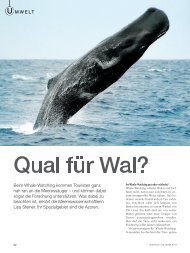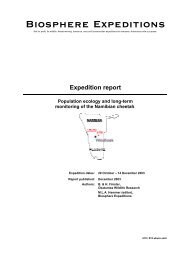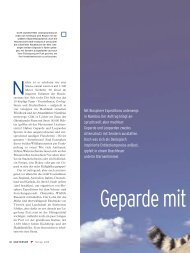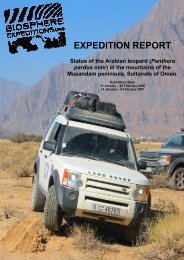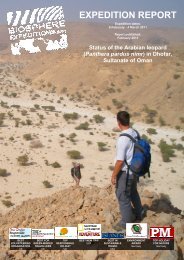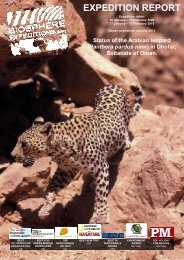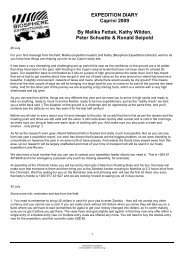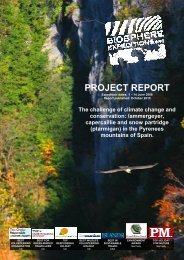EXPEDITION REPORT - Biosphere Expeditions
EXPEDITION REPORT - Biosphere Expeditions
EXPEDITION REPORT - Biosphere Expeditions
Create successful ePaper yourself
Turn your PDF publications into a flip-book with our unique Google optimized e-Paper software.
animals starve to death. Another option is to feed the animals, but this has financial<br />
implications and many game species do not take any fodder. If management is done<br />
properly, game-proof fenced areas can be very good conservation tools, for rare species in<br />
particular.<br />
In our previous study site (Omitara and Seeis) an average of 211 animals per transect<br />
were detected. This number is more than four times that of Okomitundu. This is because<br />
Okomitundu is more arid than the Seeis region and therefore grazing and browsing<br />
capacity is lower. Assuming that large carnivore density is limited by the availability of prey<br />
animals, it is not surprising that fewer carnivores are present at Okomitundu compared to<br />
Seeis. This is also supported by the Large Carnivore Atlas programme (Stander &<br />
Hanssen 2003) as well as our spoor data (see 2.5.3.).<br />
Leopards mainly range in the western parts of Okomitundu. Their prey availability within<br />
the game-proof fenced area did not change significantly in any of the three years. Besides<br />
that some leopards were shot, which meant that territories were available for takeover. So<br />
it is not surprising that the number of leopards increased from five individuals in 2005 to<br />
eight individuals in 2006 and nine individuals in 2007.<br />
Regarding cheetahs, which mainly range in the eastern parts of the area, conditions<br />
deteriorated in 2006 as prey availability on the open farmland dropped to less than half<br />
that in 2005. Secondly, the composition of prey species was dominated by oryx, which are<br />
good at fighting off predators. Thirdly, the dominance of the male coalition as described<br />
above makes it difficult for single cheetahs to move in. This explains why the number of<br />
individual cheetahs decreased from nine animals in 2005 to five animals in 2006. In 2007<br />
game numbers on the open farmland increased and prey composition was dominated by<br />
kudu instead of oryx. Living conditions for cheetahs became more favourable again and<br />
the number of cheetahs increased to seven individuals.<br />
2.7. Poaching<br />
2.7.1. Introduction<br />
Poaching activities are one of the most serious threats to wildlife populations. Usually<br />
poachers on Namibian farmland work with dogs and donkeys and they often destroy<br />
fences by cutting wires. Since Okomitundu borders onto Otjimbingwe (a housing estate of<br />
landless people) as well as two resettlement farms, the farm boundaries need to be<br />
checked regularly. Throughout the year this effort cannot be sustained on a daily basis.<br />
First of all the total fence line is about 70 km, secondly some parts of the fence are difficult<br />
to access, and thirdly there is simply no time for the limited number of farm staff to do this.<br />
During expeditions it is therefore a great asset to the study site to have the manpower<br />
necessary to check parts of the border fence frequently. Scientifically this activity aims to<br />
gather information about large carnivore tracks entering or leaving the core area and about<br />
poaching activity.<br />
50<br />
� Okatumba Wildlife Research<br />
www.okatumba.de



